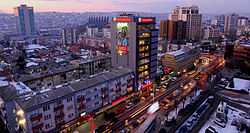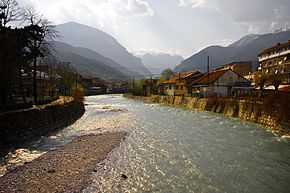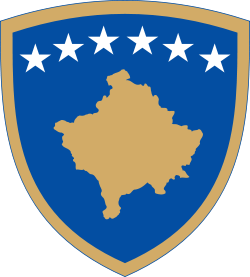Ferizaj
| Ferizaj | ||
|---|---|---|
| Municipality and city | ||
| Albanian: Ferizaj; Serbian: Uroševac/ Урошевац; Turkish: Ferizovik | ||
| ||
 Ferizaj Location in Kosovo | ||
| Coordinates: 42°22′N 21°10′E / 42.367°N 21.167°ECoordinates: 42°22′N 21°10′E / 42.367°N 21.167°E | ||
| Country | Kosovo[lower-alpha 1] | |
| District | District of Ferizaj | |
| Government | ||
| • Mayor | Muharrem Svarqa LDK | |
| Area | ||
| • Municipality and city | 345 km2 (133 sq mi) | |
| • Urban | 10.537 km2 (4.068 sq mi) | |
| Elevation | 500 m (1,600 ft) | |
| Population (2011) | ||
| • Municipality and city | 108,690 (municipality) | |
| • Density | 315.4/km2 (817/sq mi) | |
| • Metro | 68.000 City | |
| Time zone | CET (UTC+1) | |
| • Summer (DST) | CEST (UTC+2) | |
| Postal code | 70000 | |
| Area code(s) | 0290 | |
| Car plates | 05 | |
| Website | Municipality of Ferizaj (Albanian) | |
Ferizaj (Albanian: Ferizaj; Serbian: Uroševac/ Урошевац; Turkish: Ferizovik) is a city and municipality in southern Kosovo,[lower-alpha 1] located approximately 38 kilometers (24 mi) south of the capital Pristina. Founded and named after the local hotelier Feriz Shashivari in the 19th century, the city was renamed Uroševac on the occasion of its annexation to Serbia in 1913. Ferizaj is the third most populous city in Kosovo, after Pristina and Prizren. It is the administrative center of the homonymous district. The central city postal codes include 70000, 70010, 70030 and 70040.
The municipality covers an area of 345 km2 (133 sq mi), including the city of Ferizaj and 45 villages. It is largely an agricultural plain. Its population is estimated at 108,690.[1]
History
The town, officially named Ferizovik when it was part of the Ottoman Empire, was little more than a village until 1873, when the Belgrade-Thessaloniki railway was opened, passing through the town. The name derives from a pre-1873 hotel owned by a local Feriz Shashivari.
Balkan Wars
After the settlement had fallen to Serbia during the First Balkan War, the local Albanian population offered determined resistance. According to certain reports, the fight lasted three days.[2] The Serbian commander, then, ordered the population back home and to surrender. When the survivors returned, between 300–400 men were executed[2] and according to the Catholic Archbishop of Skopje, Lazër Mjeda, only three Muslim Albanians over the age of fifteen had been left alive.[3] There then followed the destruction of Albanian-populated villages around Ferizovik.[4] Before the Treaty of London in 1913 made Ferizovik a part of the Kingdom of Serbia, the name was changed to Uroševac, after Stefan Uroš V of Serbia.[5]
Kingdom of Yugoslavia
From 1929 to 1941, Uroševac was part of the Vardar Banovina of the Kingdom of Yugoslavia.
Kosovo War
The city suffered some damage during the Kosovo War of 1999, with some of its Albanian-populated neighborhoods being shelled and burned by the Yugoslav Army. Following the war, the city has seen serious inter-communal unrest, which resulted in almost all of the Serbians and rest of non-Albanian inhabitants being expelled or to flee.
Camp Bondsteel, the main base of the United States Army detachment to the KFOR peacekeeping force in Kosovo is located nearby.

Archaeology
Kosovo has a very valuable asset of archaeology but a handicap in this field are still institutional serious researches. Anyway, from up to know researches The Archaeology of Kosovo is included in Encyclopedia of Global Archaeology as a country with a wealthy archaeological heritage. The favorable geostrategic and wealthy natural resources were ideal for the development of life since the prehistoric periods, proven by traces of the hundreds of archaeological sites discovered and identified throughout Kosovo, which proudly presents the rich and abundant archaeological heritage of our country.
By the end of 19th century came out the first scientific data for the archaeological legacy of Kosovo, owing to work of the researchers: A. Evans and F. Kanitz. The entire archaeological activity of Kosovo begins after the establishment of the Museum of Kosovo in 1949.
From many world and European archaeologist is suggested that the Municipality of Ferizaj is counted among the localities that has a highly valued asset of the archaeological legacy.
Economy
The US company "Brown & Root," assisting in constructing the Camp Bondsteel, is a major employer in the municipality with 1,500 people locally employed. Most of the 22 socially-owned enterprises have been privatized. According to statistical information from the Ministry of Trade and Industry, there are more than 4,500 private small and medium-sized businesses registered in the municipality while the municipal registry counts 3,463 active local businesses. The municipal figures of local active companies show that 11% are production oriented, 43% provide services, and 46% of businesses are trade-oriented.[1]
Education

There are 30 primary schools in the municipality and 22,771 students. Six secondary schools include gymnasium and professional schools (technical, medical, music, agricultural and economics) with 7,054 students in total. The school attendance of the Ashkali, Roma and Gorani children is lower than the Kosovo Albanians. There is also one kindergarten with a total of 270 children registered. The Municipal Department of Education and Science has more than 1,680 professional and support staff, including 10 minority communities representatives.[6] Ferizaj has two public libraries, where student also have internet access. Membership prices are very symbolic.
Culture
The Big Mosque of Mulla Veseli from 1891 and the St. Uroš Orthodox Cathedral[7] located in the centre of Ferizaj are considered as a symbol of religious tolerance between Muslim Albanians and Christian Serbs. The mosque was destroyed during World War II, but then rebuilt. During the Kosovo War in 1999 neither was destroyed. In March 2004 during unrest in Kosovo, the church was attacked. Because the mosque and the church are in the same place, many people like to make photos as a unique phenomenon.
It should be emphasized that the development of art and culture in Kosovo is closely related to cultural and artistic society (CAS), which initially did during World War II and then disposed of the first efforts by prominent artist to professional art the opening of gymnasium schools and professionalized ones in the town of Ferizaj. Activities date back to the early 40s that lam after century, which were constructed in a well-organized structure, where musical performances took place in parallel and scene. One of the figures that has left deep traces in professional art in Kosovo and in wider spaces is the composer Lorenc Antoni whom we find in the early 40s engaged in Ferizaj. When it is mentioned Lorenc Antoni, it also should be mentioned the other composer Venqenc Gjini from Ferizaj who has given too much contribution in culture and is always respected countrywide especially with his creative idioms inspired by the popular fountain.[8]

Sport
Three football clubs are situated in Ferizaj: KF Ferizaj, KF Vullnetari i UÇK-së and KF Vizioni. Ferizaj is center for sports except for handball, where it has one teams in the top league: KH Kastrioti.
Media
There are 3 TV stations and 4 radio stations licensed and operational in Ferizaj. All the local media are privately owned: RTV TEMA, TV Liria, RTV Festina, Radio Ferizaj and Radio Furtuna.
Demographics
There is no correct information on the exact figure on the municipality's population, as the last census took place in 1991. However, as of 2011 municipal authorities estimate the population to 108,690. The majority, roughly 100,000 residents, are Kosovo Albanian. The other groups are as follows: Ashkali (3,500 residents), Roma (200 residents), Gorani (150 residents), Bosniak (60 residents), and other communities (40 residents), including Turks.[1]
The city had a population of about 70,000 people in the 1990s but this has grown substantially as a result of Albanian migration from the countryside and from parts of southern Serbia.[5]
In 1998, before the 1999 Kosovo War, the population was recorded as 57,421, of whom 82.1% were Albanian, 9.4% Serb, and the remainder from various other national communities. In 2003 the town had a total population of 139,800.
Notable people
- Shtjefën Kurti, priest
- Arsim Abazi, footballer
- Lucjan Avgustini, prelate
- Genc Iseni, footballer
- Shefqet Pllana, ethnographer
- Ljuba Tadić, actor
- Čika Mišo, shoeshiner
- Driton Ramadani, journalist
Gallery
-

The railway line at Ferizaj 1903.
-

Municipality of Ferizaj
-

"Dëshmorët e Kombit" street
-

Ljuboten mountain
-

Jeronim De Rada school
-

Train passing through Ferizaj
-

Ferizaj
-

Objektet Fetare ne Ferizaj
-

Parku i Lirisë ne Ferizaj
Notes
Notes:
- ↑ 1.0 1.1 Kosovo is the subject of a territorial dispute between the Republic of Serbia and the Republic of Kosovo. The latter declared independence on 17 February 2008, but Serbia continues to claim it as part of its own sovereign territory. Kosovo's independence has been recognised by 108 out of 193 United Nations member states.
References
- ↑ 1.0 1.1 1.2 OSCE Mission in Kosovo: Municipal profile of Ferizaj PDF, October 2007. Retrieved on 10 March 2008.
- ↑ 2.0 2.1 "Leo Freundlich: Albania's Golgotha". Albanianhistory.net. Retrieved 2014-04-17.
- ↑ Noel Malcolm (1998). Kosovo: A Short History. London: papermac. p. 254. ISBN 9780330412247.
- ↑ "Leo Trotsky: Behind the Curtains of the Balkan Wars". Albanianhistory.net. 1912-12-23. Retrieved 2014-04-17.
- ↑ 5.0 5.1 Elsie, Robert (2004). Historical dictionary of Kosova. Scarecrow Press. p. 58. ISBN 0-8108-5309-4.
- ↑ OSCE Mission in Kosovo: Municipal profile of Ferizaj PDF, October 2007. Retrieved on 10 March 2008.
Source: Acting Director, Municipal Department of Education and Science. - ↑ English Edition (2010-09-15). "Greek Kosovo Force Reopens Damaged St. Uros Cathedral, Urosevac / OrthoChristian.Com". Pravoslavie.ru. Retrieved 2014-04-17.
- ↑ Grup autoresh Ferizaj dhe rrethina, Beograd, 1975, page 262
External links
| Wikimedia Commons has media related to Uroševac. |
| ||||||||||||||||||||||||||||||||
| | |||||||||
|---|---|---|---|---|---|---|---|---|---|
| Rank | Name | Districts | Pop. | Rank | Name | Districts | Pop. | ||
 Pristina Prizren |
1 | Pristina | Pristina | 208,230 | 11 | Glogovac (Drenas) | Pristina | 60,687 |  Ferizaj (Uroševac)  Peć |
| 2 | Prizren | Prizren | 183,810 | 12 | Lipljan | Pristina | 59,773 | ||
| 3 | Ferizaj (Uroševac) | Ferizaj (Uroševac) | 112,657 | 13 | Orahovac | Gjakova | 58,259 | ||
| 4 | Peć | Peć | 98,603 | 14 | Mališevo | Prizren | 57,136 | ||
| 5 | Gjakova | Gjakova | 97,127 | 15 | Skenderaj (Srbica) | Mitrovica | 52,175 | ||
| 6 | Gjilan | Gjilan | 92,369 | 16 | Vitina | Gjilan | 48,288 | ||
| 7 | Podujevo | Pristina | 90,568 | 17 | Deçan | Peć | 40,954 | ||
| 8 | Mitrovica | Mitrovica | 84,949 | 18 | Istok | Peć | 40,388 | ||
| 9 | Vučitrn | Mitrovica | 71,977 | 19 | Klina | Peć | 39,943 | ||
| 10 | Suva Reka | Prizren | 61,976 | 20 | Kamenica | Gjilan | 35,931 | ||

